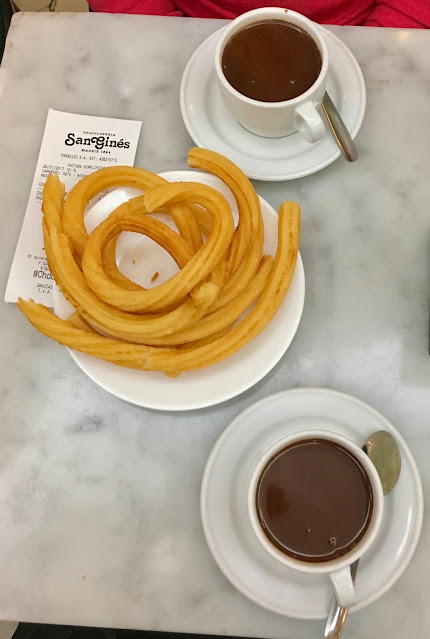Madrileños enjoy their food. There are restaurants everywhere, not to mention tapas bars, cervezcerias, cafés, and other places where you treat yourself to anything from a small plate to a multi-course meal.
Like Rome, but unlike more cosmopolitan cities such as Paris, London, and New York, the city lacks a wide variety of cuisines. Madrileños prefer to stick with their traditional cooking. Sure, there are sushi bars, pizza parlors, Indian and Chinese restaurants, but they are conspicuously few in number and cater more to tourists than to locals.
Madrid eats what it eats. And what it eats is very tasty.
O and I were not so impressed. I love chocolate, and the sight and smell of the thick, dark brew that was put before us after a half-hour wait was intoxicating. The chocolate looked almost dense enough to chew.
Unfortunately, it turned out to be way too sugary for us. I like my chocolate dark and bittersweet, and there was no bitterness in this cup. Neither of us could drink more than a few sips. Dipping the not-so-sweet churros in it helped cut the sugar, but we still couldn't finish even half a cup.
Our first try at tapas here was rather more successful. Jamón ibérico is reputed to be the world's finest ham, and we found it lived up to the hype. Even O, who is not a fan of ham was impressed by its nutty, buttery flavor. The olives and cheeses are also amazingly tasty.
Our next culinary adventure was to try Madrid's quintessential winter dish, cocido madrileño. This chickpea-based stew is cooked for at least three hours and includes a variety of ingredients and flavors.
It probably has its roots in a dish cooked by Sephardic Jews in medieval times, but it has been modified substantially since, especially during the Inquisition when the fear of being denounced as Jewish forced Christians and Marranos (converted Jews) to incorporate pork into their meals.
Now, lard, bacon, chorizo, and chicken are added, along with potatoes, cabbage, carrots, and turnips. Ham bone and beef spine are used to enrich the stock.
The stew is served in two or three different courses, or vuelcos. First the stock is drained into a bowl with noodles and served with green onion and a peck of pickled peppers.
The second vuelco consists of the chickpeas and the vegetables. The third is the meat dish. Or the meat and vegetables can be served together. The result is a hearty, satisfying meal--comfort food at its finest.
The hot drink in Madrid right now is gin-and-tonic, or as Madrileños say "geentoenik." This was a particularly delicious version, with juniper berries and extra lime.
Another dish we loved was stewed beans and meat. There are several varieties of beans, and they are paired with anything from chicken to pork belly, jamón, or chorizo.
Bursting with hearty, mouth-filling flavors. Even more so when accompanied by grilled artichoke hearts stuffed with ham and olives.
One of my favorite dishes so far: wild rabbit wrapped in bacon and stuffed with ham and foie gras. Smoky and savory and soul-satisfying.
The goat cheese here is superb, either fresh, grilled or baked, as in this lovely salad featuring pomegranate seeds, toasted pine nuts and walnuts, and every salad green known to man.
Jamón Ibérico de Bellota is the finest grade of ham in Spain, with extra marbling that comes from a diet of acorns. The roasted almonds have a different taste than those back home--almost meaty. They're a perfect accompaniment to the ham. The toast with tomato puree is eaten with the ham, though both are excellent on their own. Freshly made potato chips are very popular and definitely superior to the packaged versions we're used to. There are potato chip shops that sell them hot out of the fryer, though most restaurants make their own,
Finally, one of the best desserts ever: tiramisu mousse with buttery coffee ice cream.
Madrid's cuisine may be limited, but it would probably take me a month or two before I needed a break. I'd certainly like the opportunity to get tired of it.
P.












No comments:
Post a Comment